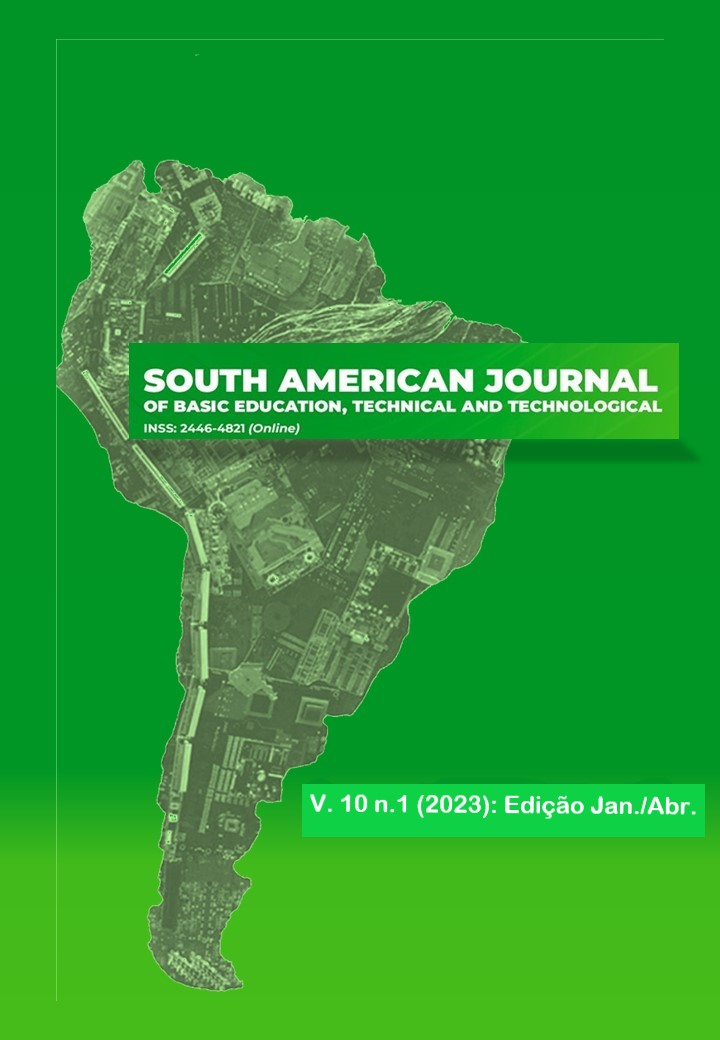DERMATOGLYPHICS, COORDINATION AND LITERACY IN PRIMARY SCHOOL: A CORRELATIONAL APPROACH
Palabras clave:
dermatoglyphics; motor coordination; literacy difficulties;Resumen
Objective: This study aimed to correlate dermatoglyphic characteristics with motor coordination of students with (Y/LD) and without literacy difficulties (N/LD). Methods: This is a cross-sectional and descriptive research, with comparative and correlational analysis. The sample consisted of 240 students (47.92% girls), aged between 6 and 11 years (7.51±0.76), dully enrolled in the primary 2nd and 3rd school years from Curitiba. Students were assessed by the following protocols: BMI; Curitiba test results, academic portfolio analysis, KTK test for motor coordination evaluation and dermatoglyphics. Results were presented using descriptive statistics. Results: Differences between groups were observed all 4 KTK tests (p< 0.01), as well as in the total motor quotient (z= 0.258, p< 0.01) and total score (z= 0.240, p< 0.01). No significant differences were noted between the dermatoglyphic variables. KTK results were strongly correlated with the Y/LD and N/LD groups (t (238) = 5.976, p< 0.01, d= 0.79). Conclusions: The study reinforced that there may be a close relationship between motor coordination and literacy difficulties.
Citas
[2] ADENOWO, T. K.; DARE, B. J. Digital and Palmer Dermatoglyphic; A Bio-Indicator for Intelligence Quotient. J. Basic Appl. Res. v.2, n.3, p.313-319, 2016.
[3] BASTOS, F. A.; DANTAS, P. S.; FERNANDES FILHO, J. Dermatoglifia, somatotipo e qualidades físicas básicas no basquetebol: estudo comparativo entre as posições. Motricidade, v.2, n.1, p.32-52, 2006.
[4] BORIN, J.; PADOVANI, C.; ARAGON, F. F.; GONÇALVES, A. Dermatoglyphics in Sports Sciences: Understanding the distribution of quantitative indicators in non-athletes and athletes of basketball according to their performance. Rev Andal Med Deporte., v.5, n.3, n.99-104, 2012. doi: 10.1016/S1888-7546(12)70015-1.
[5] CAMERON, C. E.; COTTONE, E. A.; MURRAH, W. M.; GRISSMER, D. W. How Are Motor Skills Linked to Children’s School Performance and Academic Achievement? Child Dev Perspect., v.10, n.2, p.93-98, 2016. doi:10.1111/cdep.12168.
[6] CARVALHO, M. C.; CIASCA, S. M.; RODRIGUES, S. D. Há relação entre desenvolvimento psicomotor e dificuldade de aprendizagem? Estudo comparativo de crianças com transtorno de déficit de atenção e hiperatividade, dificuldade escolar e transtorno de aprendizagem. Rev. Psicopedagogia, v.32, n.99, p.293-301, 2015.
[7] CASTILHA, F. A.; FERREIRA, H. R.; OLIVEIRA, G.; OLIVEIRA, T.; ROQUETTI FERNANDES, P.; FERNANDES FILHO, J. The influence of gene polymorphisms and genetic markers in the modulation of sports performance: a review. JEP online. v.21, n.2, p.248-264, 2018.
[8] CUMMINS, H.; MIDLO, C. Finger prints, palms and soles: an introduction to dermatoglyphics. New York, Dover Publications Inc., 1961.
[9] Fernandes Filho, J. Dermatoglífia um instrumento de prescripción em el esporte. The FIEP Bulletin. v.74, n.2-3, p.62-70, 2004.
[10] FERNANDES FILHO, J.; DE LIMA, A.; DA FONSECA, S. A.; CASTILHA, F. A. Psychomotor Profile and Learning Difficulties in Primary School Students of Labrea/AM, Brazil. South Am J Bas Educ Tech Technol., v.5, n.2, p.20-30, 2018.
[11] FERNANDES, V. R.; RIBEIRO, M, L.; SCIPIÃO, M. T.; MACIEL-PINHEIRO, P. T.; GUIMARÃES, T. T.; ARAÚJO, N. B.; RIBEIRO, S.; DESLANDES, A. C. Motor Coordination Correlates with Academic Achievement and Cognitive Function in Children. Front. Psychol., n.7, p.318, 2016. doi:10.3389/fpsyg.2016.00318
[12] GARDNER, H. Inteligências múltiplas: a teoria na prática. Porto Alegre, Artes Médicas, 1995.
[13] GESKE, A.; OZOLA A. Factors influencing reading literacy at the primary school. Probl. Educ. 21st Century, n.6, p.71-77, 2008.
[14] KIPHARD, J.; Schilling, F. Körperkoordinationstest f manual Von Fridhelm Schilling. Weinhein, Beltz Test, 1974.
[15] LAKSHMI KUMARI, K.; VIJAYA BABU, P. V. S. S.; KUMAR, S. V. Dermatoglyphics and its Relation to Intelligence Levels of Young Students. IOSR-JDMS., v.13, n.5-I, p.1-3, 2014.
[16] LUNA, A. L. S. Antropometría, coordinación motora, dermatoglifia y el proceso de alfabetización de los niños. Tesis de Magister em Ciencias de la Motricidad Humana de la Universidad Pedro de Valdivia-UPV, Chillán, Chile, 2015. 103 f.
[17] MACEDO, M. M.; FERNANDES FILHO, J. Estudo das características dermatoglíficas, somatotípicas e das qualidades físicas básicas nos diversos estágios de maturação sexual. Fit. & Perf. J., v.2, n.6, p.315-320, 2003.
[18] NAFAJI, M. Association Between Finger Patterns of Digit II and Intelligence Quotient Level in Adolescents. Iran J Pediatr., v.19, n.3, p.277-284, 2009.
[19] OFFEI, E. B.; ABLEDU, J. K.; OSABUTEY, C. K.; KESSE, D.K. Relationship between Palmar Dermatoglyphic Pattern and Academic Performance of Students in a Ghanaian Secondary School. J. Medical Biomed. Sci., v.3, n.2, p.24-31, 2014. doi:10.4314/jmbs.v3i2.5.
[20] PAIVA-NETO, F. P.; MOURÃO, D. F. A. Impressões sobre a dermatoglifia na detecção de talentos esportivos. Arquivos em Movimento, v.12, n.1, p.106-118, 2016.
[21] PINTO, D. F. S. Relação do perfil psicomotor e desempenho cognitivo em crianças com e sem dificuldades de aprendizagem. Dissertação de Mestrado em Educação Física e Desporto. Universidade de Trás-os-Montes e Alto Douro, Portugal, 2014.
[22] RAMANI, P.; PASARE RAVINDRANATH, A.; SHERLIN, H. J.; ANUJA, N.; PREMKUMAR, P.; CHANDRASEKAR, T.; SENTAMILSELVI, G.; JANAKI, V. R. Conventional dermatoglyphics –revived concept: a review. Int Journal of Pharma and Bio Sciences. v.2, n.3, p.446-458, 2011.
[23] SANZANA, M. B.; SALVO, S.; MIERES, M.; MANSILLA, J.; HEDERICH, C. Perfiles de desempeño académico: la importancia de las expectativas familiares. Perf. latinoam. [online]., v.25, n.50, p.361-86, 2017. doi: 10.18504/pl2550-016-2017.
[24] TEIXEIRA, J. A. L.; SANTOS, F. M.; AZEVEDO, F. D. L.; ANDRADE, I. F.; SOUZA, S. F. Análise do perfil psicomotor de escolares do ensino infantil. Psic. Sab. e Prát., v.8, n.11, n.4-10, 2019.
[25] ZARY, J. C.; REIS, V.; ROUBOA, A.; SILVA, A.; FERNANDES, P. R.; FERNANDES FILHO, J. The somatotype and dermatoglyphic profiles of adult, junior and juvenile male Brazilian top-level volleyball players. Science & Sports - SCI SPORT. v.25, p.146-152. 2010. doi: 10.1016/j.scispo.2009.09.002.










